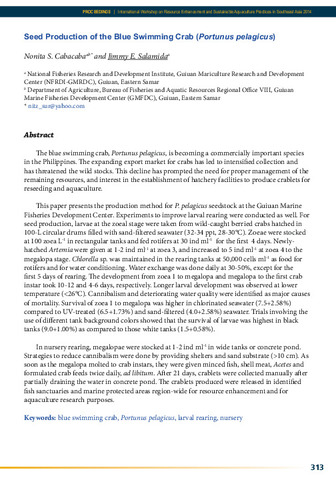Seed production of the blue swimming crab (Portunus pelagicus)
Share
Abstract
The blue swimming crab, Portunus pelagicus, is becoming a commercially important species in the Philippines. The expanding export market for crabs has led to intensified collection and has threatened the wild stocks. This decline has prompted the need for proper management of the remaining resources, and interest in the establishment of hatchery facilities to produce crablets for reseeding and aquaculture.
This paper presents the production method for P. pelagicus seedstock at the Guiuan Marine Fisheries Development Center. Experiments to improve larval rearing were conducted as well. For seed production, larvae at the zoeal stage were taken from wild-caught berried crabs hatched in 100-L circular drums filled with sand-filtered seawater (32-34 ppt, 28-30°C). Zoeae were stocked at 100 zoea L-1 in rectangular tanks and fed rotifers at 30 ind ml-1 for the first 4 days. Newlyhatched Artemia were given at 1-2 ind ml-1 at zoea 3, and increased to 5 ind ml-1 at zoea 4 to the megalopa stage. Chlorella sp. was maintained in the rearing tanks at 50,000 cells ml-1 as food for rotifers and for water conditioning. Water exchange was done daily at 30-50%, except for the first 5 days of rearing. The development from zoea 1 to megalopa and megalopa to the first crab instar took 10-12 and 4-6 days, respectively. Longer larval development was observed at lower temperature (<26°C). Cannibalism and deteriorating water quality were identified as major causes of mortality. Survival of zoea 1 to megalopa was higher in chlorinated seawater (7.5+2.58%) compared to UV-treated (6.5+1.73%) and sand-filtered (4.0+2.58%) seawater. Trials involving the use of different tank background colors showed that the survival of larvae was highest in black tanks (9.0+1.00%) as compared to those white tanks (1.5+0.58%).
In nursery rearing, megalopae were stocked at 1-2 ind ml-1 in wide tanks or concrete pond. Strategies to reduce cannibalism were done by providing shelters and sand substrate (>10 cm). As soon as the megalopa molted to crab instars, they were given minced fish, shell meat, Acetes and formulated crab feeds twice daily, ad libitum. After 21 days, crablets were collected manually after partially draining the water in concrete pond. The crablets produced were released in identified fish sanctuaries and marine protected areas region-wide for resource enhancement and for aquaculture research purposes.
Paglalarawan
Abstract only.
Suggested Citation
Cabacaba, N. S., & Salamida, J. E. (2015). Seed production of the blue swimming crab (Portunus pelagicus). In M. R. R. Romana-Eguia, F. D. Parado-Estepa, N. D. Salayo, & M. J. H. Lebata-Ramos (Eds.), Resource Enhancement and Sustainable Aquaculture Practices in Southeast Asia: Challenges in Responsible Production of Aquatic Species: Proceedings of the International Workshop on Resource Enhancement and Sustainable Aquaculture Practices in Southeast Asia 2014 (RESA) (p. 313). Tigbauan, Iloilo, Philippines: Aquaculture Department, Southeast Asian Fisheries Development Center.

